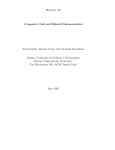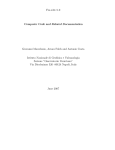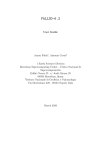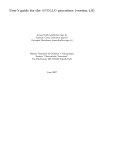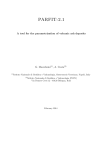Download Hazmap Arnau Folch, Antonio Costa and Giovanni Macedonio
Transcript
Hazmap Computer Code and Related Doumentation Arnau Folch, Antonio Costa and Giovanni Macedonio Istituto Nazionale di Geofisica e Vulcanologia Sezione ”Osservatorio Vesuviano” Via Diocleziano 326 -80124 Napoli, Italy February 2008 2 HAZMAP 3.1 USER MANUAL Contents 1 Introduction 3 2 Program setup 2.1 Installation . . . . . . . . . . . . . . . . . . . . . . . . . . . . . . . . . . . . . . . . . . . . 2.2 Folder structure . . . . . . . . . . . . . . . . . . . . . . . . . . . . . . . . . . . . . . . . . . 2.3 Program run . . . . . . . . . . . . . . . . . . . . . . . . . . . . . . . . . . . . . . . . . . . 4 4 5 5 3 The Hazmap input files 3.1 The control file FileInp . . . . 3.1.1 BLOCK TIME UTC . . 3.1.2 BLOCK GRID . . . . . 3.1.3 BLOCK HAZMAP . . . 3.2 The source file FileSrc . . . . 3.3 The granulometry file FileGrn 3.4 The meteo data file FileMet . . . . . . . . 6 6 6 6 6 7 7 8 4 The Hazmap output files 4.1 The list file FileLst . . . . . . . . . . . . . . . . . . . . . . . . . . . . . . . . . . . . . . . 4.2 The results file FileRes . . . . . . . . . . . . . . . . . . . . . . . . . . . . . . . . . . . . . 9 9 9 . . . . . . . . . . . . . . . . . . . . . . . . . . . . . . . . . . . . . . . . . . . . . . . . . . . . . . . . 5 The utility programs 5.1 The program SetGrn . . . . . . . . . . . . 5.1.1 Program execution . . . . . . . . . . . 5.1.2 The GRANULOMETRY block . . . . 5.2 The program SetSrc . . . . . . . . . . . . . 5.2.1 Program execution . . . . . . . . . . . 5.2.2 The SOURCE block . . . . . . . . . . 5.3 The program HazmapPostp . . . . . . . . . 5.3.1 Program execution . . . . . . . . . . . 5.3.2 The POSTPROCESS MODELS block 5.3.3 The regional topography file FileTop 5.3.4 The symbols file FileSym . . . . . . . . . . . . . . . . . . . . . . . . . . . . . . . . . . . . . . . . . . . . . . . . . . . . . . . . . . . . . . . . . . . . . . . . . . . . . . . . . . . . . . . . . . . . . . . . . . . . . . . . . . . . . . . . . . . . . . . . . . . . . . . . . . . . . . . . . . . . . . . . . . . . . . . . . . . . . . . . . . . . . . . . . . . . . . . . . . . . . . . . . . . . . . . . . . . . . . . . . . . . . . . . . . . . . . . . . . . . . . . . . . . . . . . . . . . . . . . . . . . . . . . . . . . . . . . . . . . . . . . . . . . . . . . . . . . . . . . . . . . . . . . . . . . . . . . . . . . . . . . . . . . . . . . . . . . . . . . . . . . . . . . . . . . . . . . . . . . . . . . . . . . . . . . . . . . . . . . . . . . . . . . . . . . . . . . . . . . . . . . . . . . . . . . . . . . . . . . . . . . . . . . . . . . . . . . . . . . . . . . . . . . . . . . . . . . . . . . . . . . . . . . . . . 10 10 10 10 10 11 11 12 12 13 14 15 6 Application example 15 7 References 17 3 HAZMAP 3.1 USER MANUAL 1 Introduction Hazmap is a FORTRAN90 code for the solution of the equation of diffusion, transport and sedimentation of small particles, in order to model the dispersion of ash generated by a convective column. Under the approximations of a constant horizontally uniform wind field and negligible vertical advection and diffusion, this equation reduces to: 2 ∂Cj ∂Cj ∂ 2 Cj ∂(vsj Cj ) ∂ Cj ∂Cj + Sj (1) + + ux + uy − =K ∂t ∂x ∂y ∂z ∂x2 ∂y 2 where Cj is the concentration of the particle class j having a settling velocity vsj , u = (ux , uy ) is the wind velocity, K is the (constant) horizontal turbulent diffusion coefficient, and Sj is the source term. Equation (1) is solved for each particle class independently, i.e. assuming no interaction between particles belonging to different classes during the transport process. The generic particle class j is defined by triplet of values characterizing each particle (dp , ρp , Fp ), that are, respectively, diameter, density, and a shape factor. For dp we use the equivalent diameter d, which is the diameter of a sphere of equivalent volume. For the shape factor Fp we choose the sphericity ψ, which is the ratio of the surface area of a sphere with diameter d to the surface area of the particle. In our approximation, each triplet (d, ρp , ψ) is sufficient to define the settling velocity value vsj . Since equation (1) is linear in mass, an instantaneous release of the total mass from the eruption column can be assumed if wind and diffusion parameters do not change significantly with time and only the final deposit is needed. This quasi-steady approach is assumed to hold during each simulation time interval. Considering these approximations, the above equation has a semi-analytical solution as described in (Macedonio et al., 2005). The computational domain is split into thin horizontal layers that fall to the ground together with the particles originally contained in a given initial vertical interval [zi , zi+1 ] at time t = 0. An analytical solution is then found for each layer. Since the whole treatment is done separately for each class of particles and no vertical diffusion and wind advection takes place, all particles falling from the same initial height remain at all times at the same altitude. While the centre of each cloud is translated by wind, the cloud spreads horizontally due to diffusion and settles by gravity until it reaches the ground where it forms the deposit. The model outputs therefore accumulations on the ground for each granulometric class. For further details see (Macedonio et al., 2005) and (Pfeiffer et al., 2005). There are several semi-empirical parameterizations for the particle settling velocity vs if one assumes that particles settle down at their terminal velocity: s 4g (ρp − ρa ) d (2) vs = 3Cd ρa where ρa and ρp denote air and particle density, respectively, d is the particle equivalent diameter, and Cd is the drag coefficient. Cd depends on the Reynolds number, Re = dvs /νa (νa = µa /ρa is the kinematic viscosity of air, µa the dynamic viscosity). In several options are possible for estimating settling velocity, such as: 1. ARASTOOPOUR model (Arastoopour et al., 1982): ( 24 (1 + 15Re0.687 ) Re ≤ 103 Cd = Re 0.44 Re > 103 (3) valid for spherical particles only. 2. GANSER model (Ganser , 1993): Cd = o 24 n 1 + 0.1118 [Re (K1 K2 )]0.6567 + ReK1 where K1 = 3/(1 + 2ψ −0.5), K2 = 101.84148(−Logψ) sphericity (ψ = 1 for spheres). 0.5743 0.4305K2 3305 1+ ReK1 K2 (4) are two shape factors, and ψ is the particle 4 HAZMAP 3.1 USER MANUAL 3. WILSON model (Wilson and Huang , 1979) using the interpolation suggested by Pfeiffer et al. (2005): p 24 −0.828 ϕ + 2 1.07 − ϕ Re ≤ 102 Re 1 − Cd |Re=102 (5) Cd = (103 − Re) 102 ≤ Re ≤ 103 1− 900 1 Re ≥ 103 where ϕ = (b + c)/2a is the particle aspect ratio (a ≥ b ≥ c denote the particle semi-axes). 4. DELLINO model (Dellino et al., 2005): vs = 1.2605 0.5206 νa Ar ξ 1.6 d (6) where Ar = d3 (ρp − ρa )ρa /µ2a is the Archimedes number, and ξ is a particle shape factor (sphericity to circularity ratio). Since for Hazmap the primary particle shape factor is the sphericity ψ, for sake of simplicity, it calculates ϕ in (5) and ξ in (6) approximating particles as prolate ellipsoids. 2 Program setup The Hazmap package comes with a set of utility programs which can be used to generate input files in the format required by Hazmap or to postprocess the results. The order of execution is the following (see Figure 1): (i) run the program SetGrn to generate the granulometry file, (ii) run the program SetSrc to generate the source term file, (iii) run Hazmap and, finally, (iv) run the program HazmapPostp to postprocess the results. Steps (i) and (ii) can be avoided if the user furnish the granulometry and source files directly. 2.1 Installation • On a Windows OS download and decompress the file hazmap-3.1.tar.gz on your selected directory. The hazmap-3.1.tar file already contains Windows executables for Hazmap and other utility programs so that it is not strictly necessary to have a FORTRAN90 compiler. The untaring of hazmap-3.1.tar will create the folders described in Table 1. • On a Unix/Linux/Mac X operating system: 1. Decompress and then untar the file hazmap-3.1.tar issuing the command “tar xvf hazmap-3.1.tar”. This will generate directory Hazmap-3.1 (see Table 1). 2. Compile the program Hazmap . Enter the directory Hazmap-3.1/Sources, then issue the command “make” to produce the executable Hazmap.exe. You can edit the Makefile to select your favourite compiler. After compilation you may issue the command “make clean” to remove unneeded files. If you are not going to run on a Windows platform you can also delete the executable Hazmap.win.exe. 3. Compile the (optional) utility program SetGrn . Enter the directory Hazmap-3.1/Utilities/SetGrn/Sources, then issue the command “make” to produce the executable SerGrn.exe. You can edit the Makefile to select your favourite compiler. After compilation you may issue the command “make clean” to remove unneeded files. If you are not going to run on a Windows platform you can also delete the executable SetGrn.win.exe. 4. Compile the (optional) utility program SetSrc . Enter the directory Hazmap-3.1/Utilities/SetSrc/Sources, then issue the command “make” to produce the executable SerSrc.exe. You can edit the Makefile to select your favourite compiler. After compilation you may issue the command “make clean” to remove unneeded files. If you are not going to run on a Windows platform you can also delete the executable SetSrc.win.exe. 5 HAZMAP 3.1 USER MANUAL Level 1 Hazmap-3.1 Level 2 Documents Runs Scripts Sources Utilities Level 3 Example SetGrn SetSrc HazmapPostp Description Contains this manual. Contains the example run. Contains the script files. Hazmap sources. SetGrn utility program. See section 5.1. SetSrc utility program. See section 5.2. HazmapPostp utility program. See section 5.3. Table 1: Default structure of Hazmap folders. 5. Compile the (optional) utility program HazmapPostp . Enter the directory Hazmap-3.1/Utilities/HazmapPostp/Sources, then issue the command “make” to produce the executable HazmapPostp.exe. You can edit the Makefile to select your favourite compiler. After compilation you may issue the command “make clean” to remove unneeded files. If you are not going to run on a Windows platform you can also delete the executable HazmapPostp.win.exe. 2.2 Folder structure Table 1 shows the folder structure. The directory Hazmap-3.1/Sources contains the Hazmap source files, the directory Hazmap-3.1/Utilities contains the programs SetGrn , SetSrc and HazmapPostp and, finally, the directory Hazmap-3.1/Runs contains the runs, one within each own folder. An example run named “Example” is provided with the installation. 2.3 Program run Hazmap can be launched typing “Hazmap.exe FileInp FileSrc FileGrn FileMet FileLst FileRes” (on a Unix/Linux/Mac X OS) or “Hazmap.win.exe FileInp FileSrc FileGrn FileMet FileLst FileRes” (on a Windows OS), where • FileInp: Name (including path) of the control input file (see section 3.1). • FileSrc: Name (including path) of the source input file (see section 3.2). • FileGrn: Name (including path) of the granulometry input file (see section 3.3). • FileMet: Name (including path) of the meteo data input file (see section 3.4). • FileLst: Name (including path) of the output list file (see section 4.1). • FileInp: Name (including path) of the Hazmap results file (see section 4.2). Note that filenames (and locations) are passed as a program call argument. It is highly recomended to launch Hazmap through the script files included in the distribution. • On a Windows OS enter the folder Hazmap-3.1/Scripts, edit the script Script-Hazmap-Win.bat to change the “problemname” variable and launch the script. • On a Mac X/Unix/Linux OS enter the folder Hazmap-3.1/Scripts, edit the script Script-Hazmap-Unix to change the “problemname” variable and launch the script. NOTE: To create a new run you can simply create a new folder, copy the control input file of the example (Example.inp) and modifiy the script line which defines the “problemname” variable. HAZMAP 3.1 USER MANUAL 6 The Hazmap input files 3 3.1 The control file FileInp The Hazmap control file is passed to the program as a call argument. This file is made up with a set of blocks that define all the computational and physical parameters needed by the dispersion model (Table 2 shows an example of control file). Parameters within a block are listed one per record, in arbitrary order, and can optionally be followed by one or more blank spaces and a comment. A detailed description of each record is given below. Real numbers can be expressed following the FORTRAN notation (e.g., 12e7 = 12 × 107 ). 3.1.1 BLOCK TIME UTC This block of data defines variables related to time. • YEAR: Current year. • MONTH: Current month (1-12). • DAY: Current day (1-31). • RUN START (HOURS AFTER 00): Run start hour (after 0000UTC). • RUN END (HOURS AFTER 00): Run end hour (after 0000UTC). 3.1.2 BLOCK GRID This block of data defines variables related to the grid at ground. • X ORIGIN (UTM M): x-coordinate of the grid bottom left corner (UTM coordinates in m). • Y ORIGIN (UTM M): y-coordinate of the grid bottom left corner (UTM coordinates in m). • CELL SIZE (KM): Grid spacing (in km). • NX: Number of grid cells along the x-direction. • NY: Number of grid cells along the y-direction. 3.1.3 BLOCK HAZMAP This block of data defines the rest of variables needed by the program. • ZLAYER (M): Heights (in m) of the z-layers in terrain following coordinates, i.e. above the vent. It is not necessary to specify the number of vertical layers since it is automatically calculated by the program. Alternatively, for regular z-layering, the user can also specify the initial value (zo ), the final value (zf ), and the increment (∆z) using the format: ZLAYER (M) FROM zo TO zf INCREMENT ∆z • TERMINAL VELOCITY MODEL: Type of terminal settling velocity model. Possibilities are ARASTOOPOUR (Arastoopour et al., 1982), GANSER (Ganser , 1993), WILSON (Wilson and Huang , 1979) and DELLINO (Dellino et al., 2005). • HORIZONTAL DIFFUSION COEFFICIENT (M2/S): Value of the diffusion coefficient K (in m2 /s). • POSTPROCESS TIME INTERVAL (HOURS): Time interval to output results (in h). HAZMAP 3.1 USER MANUAL 7 TIME UTC YEAR = 2007 MONTH = 03 DAY = 01 RUN START (HOURS AFTER 00) = 0. RUN END (HOURS AFTER 00) = 3. GRID X ORIGIN (UTM M) = 450000. Y ORIGIN (UTM M) = 4125000. CELL SIZE (KM) = 2.0 NX = 51 NY = 51 HAZMAP Z LAYER (M) FROM 0. TO 5000. INCREMENT 250. TERMINAL VELOCITY MODEL = Ganser HORIZONTAL DIFFUSION COEFFICIENT (M2/S) = 2500. POSTPROCESS TIME INTERVAL (HOURS) = 3. Table 2: Sample of the input control file FileInp. 3.2 The source file FileSrc The Hazmap source file is an ASCII file containing the definition of the source term. The source is defined at time intervals during which source values are kept constant. The number, position and values (i.e. Mass Flow Rate) of the source points can, however, vary from one time slice to another. There is no restriction on the number and duration of the time intervals. It allows, in practise, to discretize any type of source term. This file can be created by the utility program SetSrc . The file format is described in Table 3 and the meaning of the used symbols is the following: • itime1: Starting time (in sec after 00UTC) of the time slice. • itime2: End time (in sec after 00UTC) of the time slice. • nsrc: Number of source points (can vary from one interval to another). • nc: Number of granulometric classes. • MFR: Mass flow rate (in kg/s). • x: x-coordinate of the source isrc (UTM coordinates in m). • y: y-coordinate of the source isrc (UTM coordinates in m). • z: z-coordinate of the source isrc (terrain following coordinates in m, i.e. above the vent). • src: P Mass P flow rate (in kg/s) of each granulometric class for this point source. It must be verified that src(isrc, ic) = M F R. 3.3 The granulometry file FileGrn The granulometry file is an ASCII file containing the definition of the particle classes (a class is characterized by particle size, density and sphericity). This file can be created by the utility program SetGrn . Note that SetGrn only generates distributions which are Gaussian in Φ and linear in ρ and ψ. Hazmap can obviously handle with other distributions but, in this case, the granulometry file must be supplied directly by the user. The file format is described in Table 4 and the meaning of the used symbols is the following: 8 HAZMAP 3.1 USER MANUAL itime1 itime2 nsrc nc MFR x y z src(1,1) ... src(1,nc) ... x y z src(nsrc,1) ... src(nsrc,nc) Table 3: Format of the source file FileSrc. Repeat thes block for each time slice . nc diam(1) rho(1) sphe(1) fc(1) ... diam(nc) rho(nc) sphe(ic) fc(nc) Table 4: Format of the granulometry file FileGrn. • nc: Number of granulometric classes. • diam: Class diameter (in mm). • rho: Class density (in kg/m3 ). • sphe: Class sphericity. • fc: Class mass fraction (0-1). If must verify that 3.4 P fc = 1. The meteo data file FileMet The Hazmap meteo data file is an ASCII file containing wind velocities and air temperatures at different heights and for each time slice. The vertical layers at which meteo data is provided can be different in number and location from the HAZAMP z-layers defined in the record Z LAYER (M) of the control input file. The program automatically interpolates data from the formers to the latters. The file format is described in Table 5 and the meaning of the used symbols is the following: • itime1: Starting time (in sec after 00UTC) of the time slice. • itime2: End time (in sec after 00UTC) of the time slice. • nz: Number of z-layers at which meteo data is provided. • z: z-coordinate of the layer (terrain following coordinates in m). • ux: x-component of the wind velocity (in m/s). • uy: y-component of the wind velocity (in m/s). • T: Temperature (in o C). itime1 itime2 nz z(1) ux(1) uy(1) T(1) ... z(nz) ux(nz) uy(nz) T(nz) Table 5: Format of the meteo file FileMet. Repeat this block for each time slice. HAZMAP 3.1 USER MANUAL 4 4.1 9 The Hazmap output files The list file FileLst This file contains information concerning the run (summary of input data, run time error messages, CPU time, etc.). 4.2 The results file FileRes This is a binary file with the results from a Hazmap run. Results are output at the nodes of a regular 2D grid. This file must be processed by the HazmapPostp utility to produce “human readeable” files (normally in GRD format). HAZMAP 3.1 USER MANUAL 5 10 The utility programs 5.1 The program SetGrn The granulometric distribution is defined in the granulometry file (see section 3.3). The program SetGrn is an utility that reads the GRANULOMETRY block from the control input file and generates the granulometry file assuming that the mass fraction of particles follows either a linear or Gaussian distribution in Φ and that the density of particles varies linearly with Φ. Note that other granulometric distributions different from a linear/Gaussian can also be considered. However, in this case, the Hazmap granulometry file can not be generated by SetGrn but must be supplied directly by the user. 5.1.1 Program execution To run SetGrn (see section 2.1 for installation details) simply type “SetGrn.exe FileLog FileInp FileGrn” (on a Unix/Linux/Mac X OS) or “SetGrn.win.exe FileLog FileInp FileGrn” (on a Windows OS) where • FileLog: Name (including path) of the SetGrn output log file. • FileInp: Name (including path) of the control input file that contains the GRANULOMETRY block. Normally this file coincides with the Hazmap input file. • FileGrn: Name (including path) of the granulometry file. This is the output from SetGrn that is used later by Hazmap as input. Note that filenames are passed as a program call argument. It is highly recomended to launch SetGrn through the script files included in the distribution. • On a Windows OS go to the folder Hazmap-3.1/Scripts, edit the script Script-SetGrn-Win.bat to change the “problemname” variable and launch the script. • On a Mac X/Unix/Linux OS enter the folder Hazmap-3.1/Scripts, edit the script Script-SetGrn-Unix to change the “problemname” variable and launch the script. 5.1.2 The GRANULOMETRY block This block of data (see Table 6) defines the variables needed by the SetGrn program. Commonly this block is appended to Hazmap control input file. The meaning of each record is the following: • NUMBER OF CLASSES: Number of granulometric classes. • FI MEAN: Mean value of Φ (Gaussian distribution). • FI DISP: Value of σ in the Gaussian distribution. • FI RANGE: Minimum and maximum values of Φ (Φmin and Φmax respectively). • DENSITY RANGE: Values of density (in kg/m3 ) associated to Φmin and Φmax particles. Lineal interpolation is assumed. • SPHERICITY RANGE: Values of sphericity associated to Φmin and Φmax particles. Lineal interpolation is assumed. 5.2 The program SetSrc The distribution of sources is defined in a source file (see section 3.2). The program SetSrc is an utility that reads the SOURCE block from the control input file and generates a source file. The source term is constant for a given time interval but there is no limit on the number and duration of the time intervals. It allows, in practise, to discretize any kind of time-dependency (time-dependent mass flow rate, column height, etc.). The program admits three possibilities: point source (mass is released in a single source point), Suzuki distribution (Suzuki , 1983; Pfeiffer et al., 2005), and buoyant plume model (Bursik , 2001). The last option is more elaborated and involves the solution of the 1D radial-averaged plume 11 HAZMAP 3.1 USER MANUAL GRANULOMETRY NUMBER OF CLASSES = 12 FI MEAN = 1.5 FI DISP = 1.5 FI RANGE = -4. 5. DENSITY RANGE = 900. 2600. SPHERICITY RANGE = 0.8 0.9 Table 6: Sample of the SetGrn input file. Normally this block is appended at the end of the Hazmap input file. governing equations that describe the convective region of an eruptive column. These equations are intimately coupled with the wind field which, for small to medium size plumes, may induce a substantial plume bent-over and subsequent variations of plume height and mass release location. For this reason, when this option switched on, the program reads the values of the wind field from a meteorological file, computes the averaged wind direction and solves the plume governing equations for each time interval and particle class accounting for wind. Note that it introduces a time dependence in the source term even when all the eruptive parameters (mass flow rate, class fraction, etc.) are kept constant in time. 5.2.1 Program execution To run SetSrc (see section 2.1 for installation details) simply type “SetSrc.exe FileLog FileInp FileSrc FileGrn FileMet” (on a Unix/Linux/Mac X OS) or “SetSrc.win.exe FileLog FileInp FileSrc FileGrn FileMet” (on a Windows OS) where • FileLog: Name (including path) of the SetSrc output log file. • FileInp: Name (including path) of the control input file that contains the SOURCE block. Normally this file coincides with the Hazmap input file. • FileSrc: Name (including path) of the source file. This is the output from SetSrc that is used later by Hazmap as input. • FileGrn: Name (including path) of the granulometry file (normally generated previously by SetGrn ). • FileMet: Name (including path) of the meteo data file (see section 3.4). Note that filenames are passed as a program call argument. It is highly recomended to launch SetSrc through the script files included in the distribution. • On a Windows OS go to the folder Hazmap-3.1/Scripts, edit the script Script-SetSrc-Win.bat to change the “problemname” variable and launch the script. • On a Mac X/Unix/Linux OS enter the folder Hazmap-3.1/Scripts, edit the script Script-SetSrc-Unix to change the “problemname” variable and launch the script. 5.2.2 The SOURCE block This block of data (see Table 7) defines the variables needed by SetSrc . Commonly this block is appended to the Hazmap control input file. The meaning of each record is the following: • X VENT (UTM M): x-coordinate of the vent (UTM coordinates in m). • Y VENT (UTM M): y-coordinate of the vent (UTM coordinates in m). • ZVENT (M): Height (in m a.s.l.) of the vent. 12 HAZMAP 3.1 USER MANUAL SOURCE X VENT (UTM M) = 500080. Y VENT (UTM M) = 4177690. Z VENT (M) = 3030. MASS FLOW RATE (KGS) = 5d4 SOURCE TYPE = PLUME POINT SOURCE HEIGHT ABOVE VENT (M) = 2000. SUZUKI SOURCE HEIGHT ABOVE VENT (M) = 3000. A = 4. L = 5. PLUME SOURCE EXIT VELOCIY (MS) = 100. EXIT TEMPERATURE (K) = 1073. EXIT VOLATILE FRACTION (IN%) = 0. (One value for each source time interval) (Variables below are used only if SOURCE TYPE = POINT) (Variables below are used only if SOURCE TYPE = SUZUKI) (One value for each source time interval) (One value for each source time interval) (One value for each source time interval) (Variables below are used only if SOURCE TYPE = PLUME) Table 7: Sample of the SetSrc input file. Normally this block is appended at the end of the Hazmap input file. In this example a Suzuki source and two time intervals are assumed. • MASS FLOW RATE (KGS): Values of the mass flow rate (in kg/s). One value for each time interval. The duration of each time interval is constant and given by RUN START (HOURS AFTER 00) minus RUN END (HOURS AFTER 00) divided by the number of time intervals (automatically computed by the program from the number of values). • SOURCE TYPE: Type of source distribution. Possibilities are POINT, SUZUKI or PLUME. • HEIGHT ABOVE VENT (M): Height of the source (in m above the vent). One value for each time interval. • A: Parameter A in the Suzuki distribution. SOURCE TYPE = SUZUKI. One value for each time interval. Used only if • L: Parameter L in the Suzuki distribution. One value for each time interval. Used only if SOURCE TYPE = SUZUKI. • EXIT VELOCIY (MS): Magma exit velocity (in m/s) at the vent. One value for each time interval. Used only if SOURCE TYPE = PLUME. • EXIT TEMPERATURE (K): Magma exit temperature (in o K) at the vent. One value for each time interval. Used only if SOURCE TYPE = PLUME. • EXIT VOLATILE FRACTION (IN%): Magma volatile mass fraction at the vent. One value for each time interval. Used only if SOURCE TYPE = PLUME. 5.3 The program HazmapPostp The program HazmapPostp is an optional utility that reads the output binary file of Hazmap , calculates some relevant quantities at selected time instants and produces elementary maps in GRD and PS formats. Files in GRD format can be readed directly by several plotting programs like the commercial software GRAPHER. Alternativelly, the user may also generate its own plots using functions from several free packages (e.g. gnuplot in Fortran ). 5.3.1 Program execution To run HazmapPostp (see section 2.1 for installation details) simply type “HazmapPostp.exe FileLog FileInp FileRes PATHRES FileTop FileSym” (on a Unix/Linux/Mac X OS) or HAZMAP 3.1 USER MANUAL 13 “HazmapPostp.win.exe FileLog FileInp FileRes PATHRES FileTop FileSym” (on a Windows OS) where • FileLog: Name (including path) of the HazmapPostp output log file. • FileInp: Name (including path) of the control input file that contains the POSTPROCESS MODELS block. Normally this file coincides with the Hazmap input file. • FileRes: Name (including path) of the Hazmap results file. This is the output from Hazmap that is used by HazmapPostp as input. • PATHRES: Path where the HazmapPostp output files are dump. • FileTop: Name (including path) of the reginal topography file (see section 5.3.3). • FileSym: Name (including path) of the symbols file (see section 5.3.4). This file is optionally used by HazmapPostp to plot symbols and legends in the PS map files. Note that filenames are passed as a program call argument. It is highly recomended to launch HazmapPostp through the script files included in the distribution. • On a Windows OS go to the folder Hazmap-3.1/Scripts, edit the script Script-HazmapPostp-Win.bat to change the “problemname” variable and launch the script. • On a Mac X/Unix/Linux OS enter the folder Hazmap-3.1/Scripts, edit the script Script-HazmapPostp-Unix to change the “problemname” variable and launch the script. 5.3.2 The POSTPROCESS MODELS block This block of data (see Table 8) defines the variables needed by HazmapPostp . Commonly this block is appended to the Hazmap control input file. The meaning of each record is the following: • OUTPUT FILES IN GRD FORMAT: Possibilities are YES or NO. If YES, HazmapPostp plots files in GRD format. Files in GRD format can be readed directly by several plotting programs like the commercial software GRAPHER. Alternativelly, the user may also generate its own plots using functons from several free packages (e.g. gnuplot in FORTRAN). • OUTPUT FILES IN PS FORMAT: Possibilities are YES or NO. If YES, HazmapPostp plots files in PS format. • MAP TOTAL LOAD: Possibilities are YES or NO. If YES HazmapPostp plots the total ground load. • UNITS: Units of MAP TOTAL LOAD. It must be KG/M2. • CONTOUR LEVELS: Values of the contour levels for MAP TOTAL LOAD. Only used when OUTPUT FILES IN PS FORMAT is YES. • MAP CLASS LOAD: Possibilities are YES or NO. If YES HazmapPostp plots the class ground load. • UNITS: Units of MAP CLASS LOAD. It must be KG/M2. • CONTOUR LEVELS: Values of the contour levels for MAP CLASS LOAD. Only used when OUTPUT FILES IN PS FORMAT is YES. • MAP DEPOSIT THICKNESS: Possibilities are YES or NO. If YES HazmapPostp plots total deposit thickness. • UNITS: Units of MAP DEPOSIT THICKNESS. Possibilities are MM (for mm), CM (for cm), and M (for m). • COMPACTATION FACTOR: Deposit compactation factor. • CONTOUR LEVELS: Values of the contour levels for MAP DEPOSIT THICKNESS. Only used when OUTPUT FILES IN PS FORMAT is YES. 14 HAZMAP 3.1 USER MANUAL POSTPROCESS MODELS OUTPUT FILES IN GRD FORMAT = YES OUTPUT FILES IN PS FORMAT = NO MAP TOTAL LOAD = YES UNITS = KG/M2 CONTOUR LEVELS = 0.1 0.25 0.5 1. MAP CLASS LOAD = NO UNITS = KG/M2 CONTOUR LEVELS = 0.1 0.25 0.5 1. MAP DEPOSIT THICKNESS = NO UNITS = MM COMPACTATION FACTOR = 0.7 CONTOUR LEVELS = 0.1 1. 5. 10. 5. 10. 50. (Only used if OUTPUT FILES IN PS FORMAT=YES) 5. 10. 50. (Only used if OUTPUT FILES IN PS FORMAT=YES) 50. 100. 500. (Only used if OUTPUT FILES IN PS FORMAT=YES) Table 8: Sample of the HazmapPostp input file. Normally this block is appended at the end of the Hazmap input file. DSAA nx ny xo xf yo yf zmin zmax z(1,1) ... z(1,nx) ... z(ny,1) ... z(ny,nx) Table 9: Format of the topography file FileTop. 5.3.3 The regional topography file FileTop This is a file in GRD format containing the topography, typically at a regional scale. It is used by program to plot topography in the maps (Hazmap does not currently include topography). The computational domain must lay within the bounds of the topography file. The GRD file format is described in Table 9 and the meaning of the used symbols is the following: • nx: Number of cells in the x-direction. • ny: Number of cells in the y-direction. • xo: x-coordinate of the grid bottom left corner (UTM coordinates in m). • xf: x-coordinate of the grid top right corner (UTM coordinates in m). • yo: y-coordinate of the grid bottom left corner (UTM coordinates in m). • yf: y-coordinate of the grid top right corner (UTM coordinates in m). • zmin: Minimum value of z in the domain. Not used (you can use a void value). • zmax: Maximum value of z in the domain. Not used (you can use a void value). • z: Height (in m) of each grid point. 15 HAZMAP 3.1 USER MANUAL xs ys sname scode 1 ... Table 10: Format of the symbols file FileSym. Repeat the line for each symbol to be plotted. 5.3.4 The symbols file FileSym This is a file in ASCII format containing geographic information. It is optional and used by HazmapPostp program when OUTPUT FILES IN PS FORMAT = YES to plot symbols in the PS files. The file format is described in Table 10 and the meaning of the used symbols is the following: • xs: x-coordinate of the symbol (UTM in m). • ys: y-coordinate of the symbol (UTM in m). • sname: Name of the symbol as will appear in the PS file. • scode: Symbol code. See Figure 2. 6 Application example The Hazmap package includes an application example to check that the installation and compilation of the procedure has been done sucessfully. The example considers an eruption occurring at the first of March 2007. The files needed to run the example are located in the folder Hazmap-3.1/Runs/Example and are: • Example.inp. Problem control input file FileInp (see Table 2). • Example.met. Meteo file FileMet. Needed by SetSrc and Hazmap . • Example.regionaltopo.grd. Regional topography file FileTop. Needed by HazmapPostp . • Example.sym. Symbols file fileSym. Optionally used by HazmapPostp . To run the example it is necesary to proceed as follows (Scripts are located in the folder Hazmap-3.1/Scripts): 1. Launch the script Script-SerGrn-Unix (or Script-SetGrn-Win.bat in Windows OS) to run SetGrn . 2. Launch the script Script-SerSrc-Unix (or Script-SetSrc-Win.bat in Windows OS) to run SetSrc . 3. Launch the script Script-Hazmap-Unix (or Script-Hazmap-Win.bat in Windows OS) to run Hazmap . 4. Launch the script Script-HazmapPostp-Unix (or Script-HazmapPostp-Win.bat in Windows OS) to run HazmapPostp . Figure 3 shows the Hazmap deposit load at the end of the run. 16 HAZMAP 3.1 USER MANUAL FileInp Hazmap block GRANULOMETRY block SOURCE block POSTPROCESS block SETGRN FileGrn SETSRC FileMet FileSrc FileTop HAZMAP FileRes FileSym HAZMAPPOSTP FileLog FileGRD FilePS Figure 1: Execution flow for Hazmap and the utility programs. Boxes indicate I/O files. File names are passed to programs as a call argument. HAZMAP 3.1 USER MANUAL Figure 2: Symbol codes for the file FileSym. 17 18 HAZMAP 3.1 USER MANUAL HAZMAP: TOTAL DEPOSIT LOAD Date: 2007:03:01:03:0000 4225000. 4205000. o Taormina 4185000. mEtna 10 0. 1. 00 o Acireale 4165000. 0. 0.25 50 25 0. o Catania 4145000. 10 0. 4125000. 450000. 470000. MAX VALUE: MIN VALUE: 490000. 510000. 530000. 9.08 0.00 Figure 3: Deposit load (in kg/m2 ) at 0300UTC. 550000. HAZMAP 3.1 USER MANUAL 7 19 References Arastoopour, H., Wang, C., Weil, S., 1982. Particle-particle interaction force in a diluite gas-solid system. Chem. Eng. Sci. 37 (9), 1379–1386. Bursik, M., 2001. Effect of wind on the rise height of volcanic plumes. Geophys. Res. Lett. 18, 3621-3624. Dellino, P., D. Mele, R. Bonasia, G. Braia, L. La Volpe, R. Sulpizio, 2005. The analysis of the influence of pumice shape on its terminal velocity, Geophys. Res. Lett., 32, L21306. Ganser, G., 1993. A rational approachto drag prediction spherical and nonspherical particles. Powder Technology 77, 143–152. Macedonio, G., Costa, A., Longo, A., 2005. A computer model for volcanic ash fallout and assessment of subsequent hazard. Computer and Geosciences 31, 837–845. Pfeiffer, T., Costa, A., Macedonio, G., 2005. A model for the numerical simulation of tephra fall deposits. J. Volcanol. Geotherm. Res. 140, 273–294. Wilson, L., and T. C. Huang, 1979. The influence of shape on the atmospheric settling velocity of volcanic ash particles, Earth Planet. Sci. Lett. 44, 311–324. Suzuki, T., 1983. A theoretical model for dispersion of tephra. In: D. Shimozuru, I. Yokoyama (Eds.), Arc Volcanism: Physics and Tectonics, Terra Scientific Publishing Company (TERRAPUB), Tokyo.




















